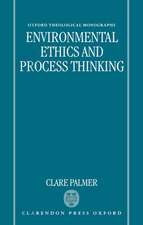Low Carbon Stabilization and Solidification of Hazardous Wastes
Editat de Daniel C.W. Tsang, Lei Wangen Limba Engleză Paperback – 21 sep 2021
Low Carbon Stabilization and Solidification of Hazardous Wastes is a necessary read for academics, postgraduates, researchers and engineers in the field of environmental science and engineering, waste management, and soil science, who need to keep up to date with the most recent advances in low-carbon technologies. This audience will develop a better understanding of these low-carbon mechanisms and advanced characterization technologies, fostering the future development of low-carbon technologies and the actualization of green and sustainable remediation.
- Focuses on stabilization/solidification for environmental remediation, as one of the most widely used environmental remediation technologies in field-scale applications
- Details the most advanced and up-to-date low-carbon sustainable technologies necessary to guide future research and sustainable development
- Provides comprehensive coverage of low-carbon solutions for treating a variety of hazardous wastes as well as contaminated soil and sediment
Preț: 709.49 lei
Nou
Puncte Express: 1064
Preț estimativ în valută:
135.76€ • 142.12$ • 112.33£
135.76€ • 142.12$ • 112.33£
Carte disponibilă
Livrare economică 17-31 martie
Livrare express 01-07 martie pentru 74.62 lei
Preluare comenzi: 021 569.72.76
Specificații
ISBN-13: 9780128240045
ISBN-10: 0128240040
Pagini: 590
Ilustrații: 65 illustrations (15 in full color)
Dimensiuni: 216 x 276 x 34 mm
Greutate: 1.35 kg
Editura: ELSEVIER SCIENCE
ISBN-10: 0128240040
Pagini: 590
Ilustrații: 65 illustrations (15 in full color)
Dimensiuni: 216 x 276 x 34 mm
Greutate: 1.35 kg
Editura: ELSEVIER SCIENCE
Public țintă
Academics, postgraduates and researchers in environmental science and environmental engineering, and waste managementCuprins
Part I Overview of environmental remediation and stabilization/solidification
1. Sustainable waste management
2. Overview of low-carbon stabilization/solidification
Part II Low-carbon stabilization/solidification (S/S) of contaminated soil and sediment
3. Green cementitious materials for S/S
4. Natural or organophilic clay for S/S
5. Nanomaterials for S/S
6. Biochar for S/S
7. S/S of contaminated river/lake sediment
8. S/S of contaminated marine sediment
Part III Low-carbon stabilization/solidification of industrial waste
9. S/S of waste incineration fly ash and bottom ash
10. S/S of waste incineration bottom ash
11. S/S of industrial sludge (electroplating)
12. S/S of industrial sludge (mining)
13. S/S of sewage sludge ash
14. Remediation of mine waste
15. Remediation of tailing waste
16. Remediation of chemical waste
17. Utilization of waste slag
18. Utilization of coal fly ash and bottom ash
19. Utilization of contaminated bio-waste
Part IV Low-carbon stabilization/solidification of radioactive waste
20. Cement-based S/S of radioactive waste
21. Glass-based S/S of radioactive waste
22. Ceramic-based S/S of radioactive waste
23. Chemical enhanced S/S of radioactive waste
Part V Future prospects
24. Novel materials for S/S technologies
25. Advanced characterization for S/S technologies
26. New lab-scale analytical methods for S/S technologies
27. Life cycle analysis of S/S technologies
28. Cost-benefit analysis of S/S technologies
29. Sustainable waste management and circular economy
30. Future research directions for sustainable remediation
1. Sustainable waste management
2. Overview of low-carbon stabilization/solidification
Part II Low-carbon stabilization/solidification (S/S) of contaminated soil and sediment
3. Green cementitious materials for S/S
4. Natural or organophilic clay for S/S
5. Nanomaterials for S/S
6. Biochar for S/S
7. S/S of contaminated river/lake sediment
8. S/S of contaminated marine sediment
Part III Low-carbon stabilization/solidification of industrial waste
9. S/S of waste incineration fly ash and bottom ash
10. S/S of waste incineration bottom ash
11. S/S of industrial sludge (electroplating)
12. S/S of industrial sludge (mining)
13. S/S of sewage sludge ash
14. Remediation of mine waste
15. Remediation of tailing waste
16. Remediation of chemical waste
17. Utilization of waste slag
18. Utilization of coal fly ash and bottom ash
19. Utilization of contaminated bio-waste
Part IV Low-carbon stabilization/solidification of radioactive waste
20. Cement-based S/S of radioactive waste
21. Glass-based S/S of radioactive waste
22. Ceramic-based S/S of radioactive waste
23. Chemical enhanced S/S of radioactive waste
Part V Future prospects
24. Novel materials for S/S technologies
25. Advanced characterization for S/S technologies
26. New lab-scale analytical methods for S/S technologies
27. Life cycle analysis of S/S technologies
28. Cost-benefit analysis of S/S technologies
29. Sustainable waste management and circular economy
30. Future research directions for sustainable remediation






















